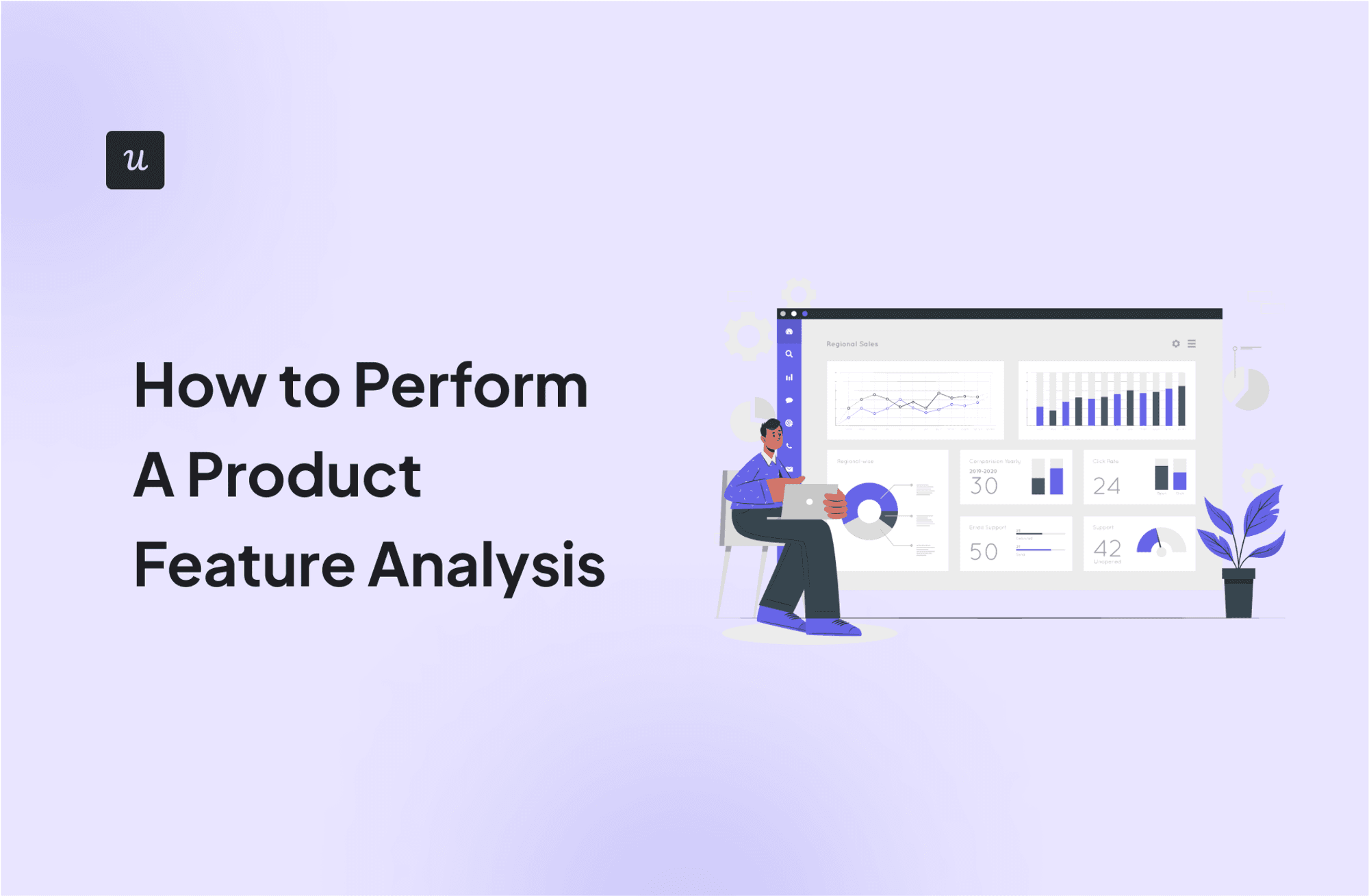
Product feature analysis is a powerful tool in the SaaS product manager’s arsenal. It empowers you to identify features that drive the highest ROIs and those that need improvement or sunsetting.
This article aims to simplify feature analysis. We cover:
- Types of product features.
- A step-by-step process for effective feature analysis.
- Best practices for optimal results.
Try Userpilot Now
See Why 1,000+ Teams Choose Userpilot

Summary of how to perform a product feature analysis
- Product feature analysis involves evaluating product features to understand their impact on user satisfaction and market performance. This analysis isn’t exclusive to SaaS; the principle applies when analyzing physical attributes for hardware products.
- It’s often done to guide product planning, enhance account expansion, and optimize self-serve customer support channels.
The insights from feature analysis help you:
- Identify feature opportunities.
- Improve product road mapping.
- Increase user retention.
- Ensure better resource allocation.
- Gain competitive advantage.
Types of product features:
- Core features.
- Usability features.
- Power features.
- Niche features.
How to effectively analyze product features:
- Define your objective.
- Specify the metrics to track.
- Tag key features for tracking.
- Review feature usage data.
- Extract feature development insights.
- Implement changes and monitor impact.
Best practices to help product managers perform feature analysis:
- Perform user research and analyze your competitors’ products to find market gaps.
- Encourage users to share feedback.
- Use segmentation to improve personalization.
- Involve cross-functional collaboration with the sales team, product team, engineering, and other relevant stakeholders.
Ready to begin? Book a demo to see how Userpilot can transform your product analysis and help you drive growth.What is a product feature analysis?
Product feature analysis involves evaluating specific features of your product to understand their impact on user satisfaction, market performance, and overall usability.
This type of analysis helps identify which features contribute positively to your product’s value and which might be redundant or underperforming.
Why perform a product feature analysis?
The insights from feature analysis help you:
- Identify feature opportunities: By gathering direct feedback and analyzing how users interact with your key features, you’ll identify user experience gaps that would otherwise have gone unnoticed.
- Improve product road mapping: Instead of relying on assumptions about what’s important, feature analysis gives you concrete data on what customers value. This guides your feature ideation process and ensures you prioritize features based on their ability to meet user needs.
- Increase user retention: Continuous product refinement based on insights from feature analysis contributes to increased user satisfaction. This enhancement in satisfaction often translates to increased user loyalty and retention as users are more likely to stick with products that evolve in line with their needs.
- Ensure better resource allocation: With a clear understanding of which features are most impactful, it becomes easy to focus time and money on developing features that offer the highest return on investment.
- Gain a competitive advantage: Feature analysis helps you understand your product’s strengths and weaknesses relative to market needs and competitor offerings. Based on these insights, you can refine your products to stay competitive.
Types of product features
There are many different ways to categorize product features depending on your goals and context.
Here’s one useful way to think about the variety of features that contribute to a product’s overall appeal and success:
- Core features: These are the foundational functionalities that your product is built around. They define the primary problem the product solves or the essential tasks it allows users to complete. For example, Slack needs instant messaging to be called a collaboration app.
- Usability features: These features enhance your product’s ease of use and overall user experience. They include elements like in-app guides, intuitive user flows, and customizable settings. Usability features might not be strictly necessary for the core functionality, but they play a significant role in user satisfaction and help potential customers decide between your tool and similar products.
- Power features: These features are often intended for more advanced or experienced users. They offer greater customization, control, or complex functionalities. For instance, Userpilot’s detailed analytics dashboards make it easy for any SaaS product team to get granular with user behavior data and extract actionable insights.
- Niche features: These features cater to the specific needs or preferences of your various segments. Niche features can be a powerful differentiator and build loyalty within that particular audience. For example, Xero, the online accounting software, has a feature that automates tax calculations based on the tax rates and rules of the user’s configured region.
How to perform product feature analysis
Follow these steps to properly analyze features and understand what moves the needle for your SaaS.
1. Define your objective for performing a feature analysis
Before you dive in, clearly outline why you’re doing the analysis. Ask yourself:
- Are you trying to identify features that drive customer retention, or those leading to churn?
- Is the goal to discover underutilized features that could be promoted differently?
- Are you looking for opportunities to add, remove, or improve current features?
Your objectives will inform your approach and the metrics to track.
If you’re unsure how to set the right goals, the S.M.A.R.T goal-setting framework helps. Ensure each target you set is specific (not something vague like “track how users are performing”), measurable, achievable, realistic, and time-bound.
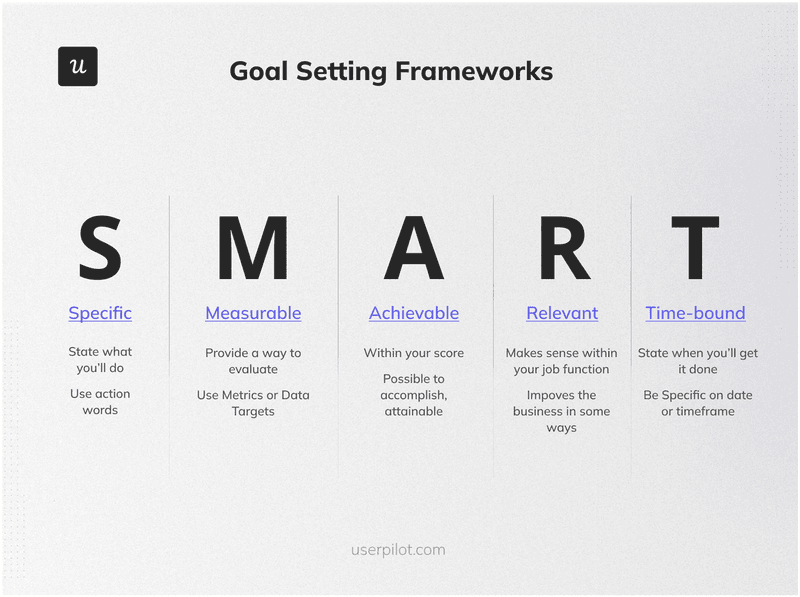
2. Specify the metrics to track
Next, define the metrics that will aid your analysis. For example, you could track feature adoption and usage to help you determine popular features.
- Feature adoption is the rate at which users adopt product features into their workflows.
- Feature usage tracks the frequency and depth of user interaction with the features they just adopted.
High feature adoption and usage are good signs that users love that feature and that it helps solve a core problem.
When tracking usage, setting a good baseline makes it easy to determine popular and unpopular features.
For example, say you expect users to interact with a key feature three to five times weekly. If most users are interacting with it less than that, it could signal that there’s an engagement problem.
3. Tag key features and events with a product analytics tool
After setting your objectives and key metrics, you’ll have a good idea of the features to track.
So the next step is to track them. Use a product analytics tool such as Userpilot to easily tag features and key events users are expected to perform. This will help collect relevant feature engagement data.
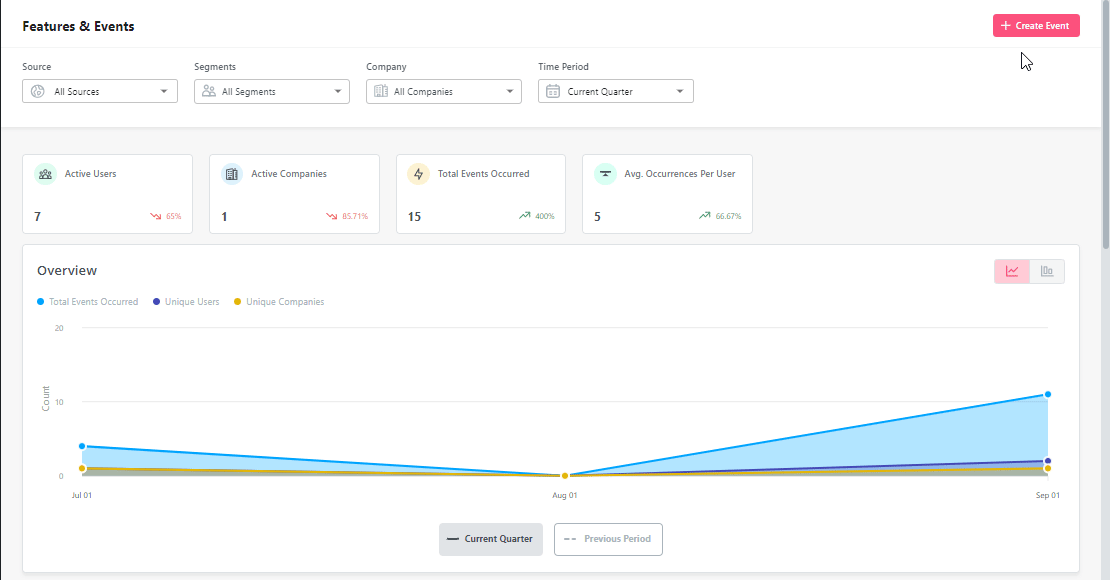
4. Collect and review feature usage data
With feature and events tagging in place, dig into your product analytics tool to track feature usage. For a deeper understanding, you can pair your usage data with any of the following analytics reports:
- Trends analysis: Shows you patterns and changes in user behavior over time.
- Session recordings: Track how users interact with your tool through recordings of individual user sessions, showing every mouse movement, click, and interaction.
Too many metrics to track? Userpilot’s core feature engagement dashboard brings all your important metrics in one place:
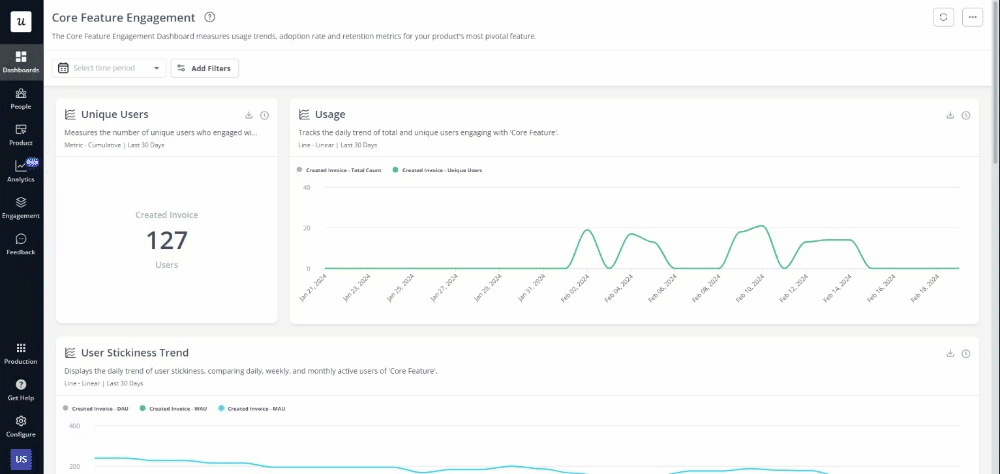
5. Analyze the data to extract new feature development insights
Review the collected data to make insightful conclusions. Look for trends over time, such as increases or decreases in usage—especially changes in behavior patterns after product updates.
Based on the data, decide which features to optimize for a better user experience and which to sunset.
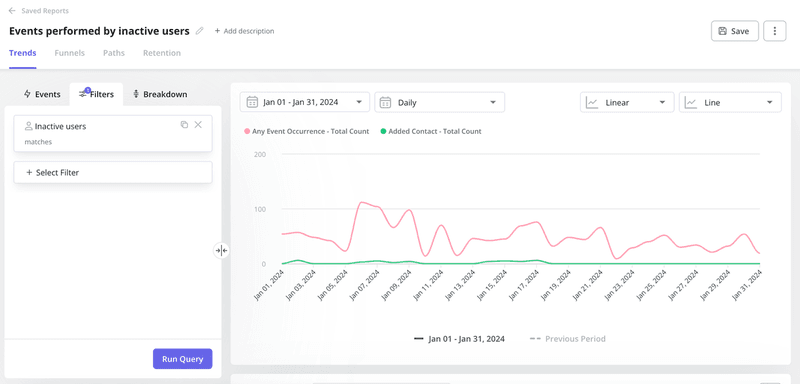
6. Implement changes and monitor impact
Feature analysis is not “one-and-done.” It’s a continuous cycle of change and measurement, so use your insights to implement changes and monitor user reactions.
The changes you make can be any of the following:
- Feature enhancements.
- Sunsetting unpopular and low ROI features.
- Adding new features that align with observed user needs.
You can also perform competitor analysis to find opportunities to exploit and stand out. For example, aim to identify features the market needs but your competitors are lacking. Add these to your product roadmap and create buzz when you launch them.
Example of a competitive product analysis
So far, we’ve discussed how to conduct an internal feature analysis. This section shows you simple ways to perform a competitive product analysis.
- Step 1: Define your scope. If you’re a product management tool, you might focus on researching features for task management, collaboration, and communication within remote teams.
- Step 2: Identify competitors. For example, a product management tool such as Trello competes with ClickUp and Asana.
- Step 3: Create a feature matrix and perform competitive analysis. Build a column as in the image below with a list of features relevant to your scope and highlight competitor strengths and weaknesses for each feature. User reviews are a valuable resource for understanding your competitors’ products, so be sure to also visit G2 and Capterra.
- Step 4: Find feature development opportunities and ways to exploit competitor weaknesses. While you do this, also ensure your tool meets the baseline requirements in your niche. For instance, most product management tools work across multiple devices. It might be a turn-off for users if yours doesn’t.
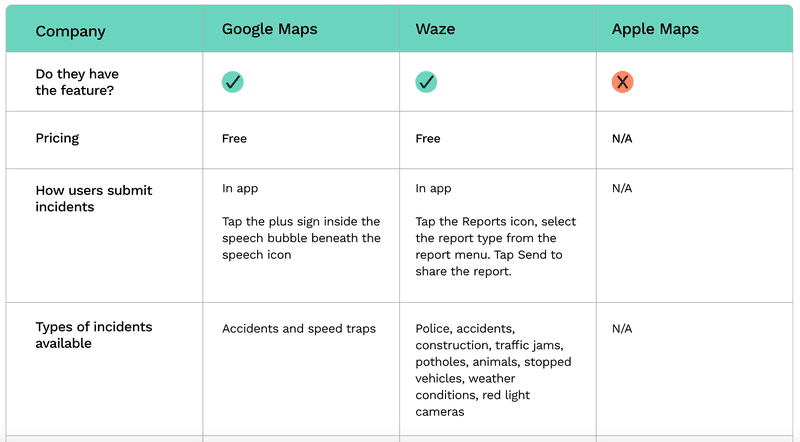
How to use product feature analysis results in SaaS
Now that you have all the feature analysis data you need, what do you do with it? Here are three ways to use your new insights:
1. Guide product planning
Use the data to steer your product’s growth trajectory. For example, if users frequently engage with a collaborative feature, consider enhancing teamwork capabilities in future product updates.
2. Enhance cross-selling and up-selling
Identify complementary features and use them to trigger cross-sell campaigns.
In addition, now that you know your power users and the features they use regularly, utilize that information to prompt contextual upsells, providing more value to users and increasing your bottom line.
3. Enhance customer support and education
Use the product usage data to understand areas where users might require additional support or training. Then, trigger contextual in-app guides using interactive walkthroughs.
You can also build a resource center or enrich an existing one with content that explains your product better and helps users engage more.
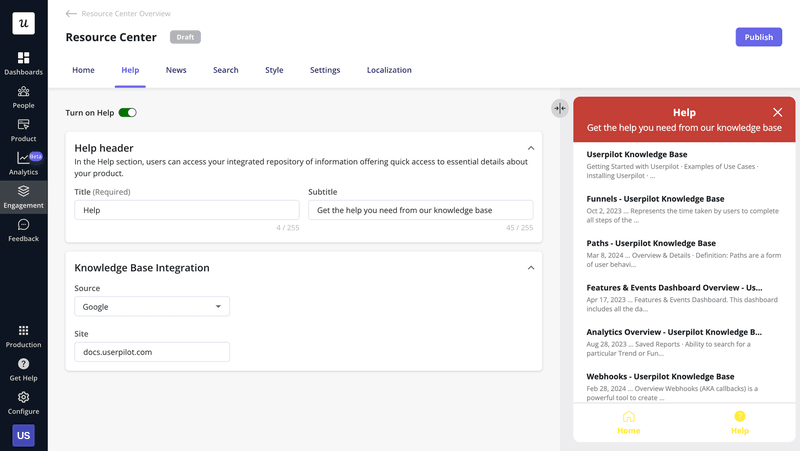
Best practices to help product managers perform a product feature analysis
Follow these best practices to ensure your analysis is effective:
- Analyze your competitors: Conduct a Strengths, Weaknesses, Opportunities, and Threats (SWOT) analysis, focusing on where your competitors are vulnerable (weaknesses) and where they are strong (strengths). Competitive analysis helps find opportunities to make your tool more delightful for existing and potential customers.
- Encourage users to share feedback: User feedback is invaluable for product feature analysis as it directly reflects how users interact with your product and what they expect from it.
- Use segmentation to improve personalization: Segment users by roles, industry, usage frequency, or any other segment you’re curious about. Analyze the feature usage across each group to understand how various segments use and perceive features differently.
- Involve cross-functional teams: Don’t work alone; involve stakeholders from various teams to get rounded insights. Each department—be it engineering, sales, marketing, or customer support—brings a unique perspective. For example, sales teams can provide insights on customer pain points, while engineering can shed light on the feasibility of potential features.
Conclusion
Feature analysis is a continuous process because customer needs and market demands keep changing. To stay competitive, you need in-depth, real-time insights into how users interact with your features.
This is where Userpilot comes in. Book a demo to see how our platform can automate your product feature analysis and help you drive growth.







